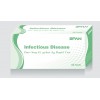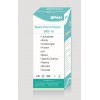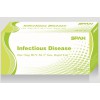INTENDED USE
The HCG Gold Rapid Screen Test (RST) is a chromatographic immunoassay for the early detection of human chronic gonadotropin (HCG) in urine specimens.
INTRODUCTION
HCG is a glycoprotein hormone secreted by the developing placenta during pregnancy. The concentration of HCG in serum is approximately equal to the concentration in urine. The concentrations of hCG in urine and serum continue to rise during the first trimester of pregnancy to as high as 100,000mIU/ml. HCG appears in urine shortly after conception, and continues to increase during the early stages of pregnancy, making it an excellent indicator for the detection of pregnancy.
PRINCIPLE
The membrane of the test device was coated with anti HCG antibodies on the test region and goat anti mouse IgG antibodies on the control region. During the test, urine specimen is allowed to react with the HCG monoclonal antibody-colloid gold conjugate, which was pre-dried on the test strip. The mixture then moves upward on the membrane chromatographically by capillary action. For a positive specimen, the conjugate binds to the HCG forming an antibody-antigen complex. This complex is captured by anti HCG antibody immobilized on the test region (T) and produces a pink color band when HCG concentration is equal to or greater than 25mIU/ml. Absence of this colored band in the test region suggests a negative result. To serve as a procedural control, a colored band at the control region(C) will always appear regardless the presence or absence of HCG.
STORAGE
The kits should be stored at temperature 4-30°C, the sealed pouch for the duration of the shelf life (24months).
PRECAUTION
1. For in vitro diagnostic use only.
2. Do not use after expiration date.
3. Test device should remain sealed until use.
REAGENTS AND MATERIALS PROVIDED
1. One pouched cassette with desiccant.
2. One piece of operating instruction
MATERIALS NOT PROVIDED BUT REQUIRED
1.Urine specimen collection container, either plastic or class.
2.Timer.
SPECIMENS COLLECTION
1.The urine specimens must be collected in a clean dry container either plastic or glass without preservatives. No centrifugation or filtration of urine is required. Specimens collected at any time may be used. However the first morning urine generally contains the highest concentration of the hormone.
2. If specimens can not be tested within 3 days of collection, they should be stored refrigerated at 2-8 °C.
ASSAY PROCEDURE
1.Remove the device from pouch by tearing and label the device with specimen identification.
2.Add 2 drops (40-60ml) of urine to the sample well.
3.Wait for 5 minutes to read result, even though some positive results may be observed within a minute. Do not try to interpret results after 10 minutes.
INTERPRETATION OF RESULTS
Negative: only one colored band appears on the control region (C). No colored band in the test region(T).
Positive: In addition to the control band (C), a distinct colored band also appears in the test region (T).
Invalid: If no bands appear, or a test band appears without a control band, the test should be repeated using a new test device.
LIMITATION
1. The HCG RST is a qualitative assay and is not intended for any use other than for the early detection of pregnancy.
2. In addition to the normal elevations of HCG produced in pregnancy, a number of conditions including trophoblastic disease, proteinuria, hematuria, choriocarcinoma, ovarian and testicular teratomas cause elevated levels of HCG. These diagnosis should be considered if appropriate to the clinical evidence.
3. As with all diagnostic tests, a definitive clinical diagnosis should not be based on the results of a single test, but should only be made by the physician after all clinical and laboratory findings have been evaluated.
PERFORMANCE CHARACTERISTIC
Sensitivity:
The analytical sensitivity of HCG RST has been set at 25mIU/ml. A urine specimen contains HCG concentrations equal to or greater than 25mIU/ml HCG gives a positive result. The sensitivity was also evaluated by a panel of urine samples spiked with HCG to the concentrations of 0, 25, 50, 100, 500mIU/ml. The results are shown in Table 1.
|
HCG Concentration (mIU/ml) |
0 |
25 |
50 |
100 |
500 |
|
N = |
20 |
20 |
20 |
20 |
20 |
|
Positive |
0 |
20 |
20 |
20 |
20 |
|
Negative |
20 |
0 |
0 |
0 |
0 |
Specificity:
Specificity was determined from cross reaction studies with known amounts of Luteinizing Hormone (hLH), Follicle Stimulating Hormone (hFSH) and Thyroid Stimulating Hormone (hTSH). 500mIU/ml hLH, 1000mIU/ml hFSH and 1000mIU/ml hTSH. All gave negative results.
Accuracy:
A study was performed using a total of 66 randomly selected urine specimens. These specimens were assayed with HCG RST and a similar commercial available qualitative visual pregnancy test. The results indicated a complete agreement (36 positive specimens and 30 negative specimens).
Interference Testing:
The following substances at certain concentrations do not interfere with the HCG RST in the assay.
|
Acetaminophen |
20mg/dl |
|
Acetysalicylic acid |
20mg/dl |
|
Ascorbic acid |
20mg/dl |
|
Atropine |
20mg/dl |
|
Caffeine |
20mg/dl |
|
Gentisic acid |
20mg/dl |
|
Glucose |
2.0g/dl |
|
Hemoglobin |
1.0mg/dl |













